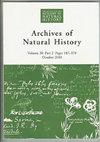History of the crested turkey, a rare variant of the domesticated turkey (Meleagris gallopavo gallopavo)
IF 0.3
4区 哲学
Q3 HISTORY & PHILOSOPHY OF SCIENCE
引用次数: 0
Abstract
In 1919, the famous Dutch poultry judge Cornelis van Gink (1890–1968) was aware of the existence of crested turkeys. Was this bird a natural rarity, variation or mutation? A search through historical records and published works yielded very few references to crested turkeys. From the financial accounts of the Great Condé in 1679 to pictures in books and journals of the eighteenth and nineteenth century in England and America, from a mounted specimen in Parma to a first photograph in 1938 in Newsweek, the beauty and rareness of this bird is evident. Attempts to breed crested turkeys were unsuccessful. In the nineteenth century William Bernhardt Tegetmeier (1816–1912), editor of The Field, had a major interest in these turkeys and together with Charles Darwin (1809–1882) studied and described skull deformations associated with well-known and common crested breeds of chickens. Deformation of the skull was also observed in the mounted specimen of the crested turkey preserved in Parma, Italy. Genetic analyses of crested poultry indicate that a mutation (autosomal incompletely dominant) in the crest gene is responsible for this phenotype. The mutation for crest formation with additional skull deformation might be responsible for some in ovo lethality or poor hatching which could explain the failure or difficulty in breeding this phenotype. In conclusion, all data indicate that the crested turkey is a mutation of the domestic turkey Meleagris gallopavo gallopavo and does not justify a new species or subspecies name.凤头火鸡的历史--驯化火鸡(Meleagris gallopavo gallopavo)的一种罕见变种
1919 年,荷兰著名的家禽法官 Cornelis van Gink(1890-1968 年)意识到了凤头火鸡的存在。这种鸟是自然界的稀有品种、变异品种还是突变品种?通过对历史记录和出版著作的搜索,很少有关于冠火鸡的记载。从 1679 年康德大帝的财务账目到十八和十九世纪英国和美国的书籍和期刊中的图片,从帕尔马的一个装裱标本到 1938 年《新闻周刊》上的第一张照片,这种鸟的美丽和稀有显而易见。饲养凤头火鸡的尝试并不成功。十九世纪,《田野》编辑威廉-伯恩哈特-泰格迈尔(William Bernhardt Tegetmeier,1816-1912 年)对这种火鸡产生了浓厚的兴趣,他与查尔斯-达尔文(Charles Darwin,1809-1882 年)一起研究并描述了与著名的普通冠鸡品种相关的头骨畸形。在保存于意大利帕尔马的冠火鸡标本中也观察到了头骨变形。对鸡冠家禽的遗传分析表明,鸡冠基因突变(常染色体不完全显性遗传)是造成这种表型的原因。嵴基因突变会导致嵴形成和额外的头骨畸形,这可能是造成卵中致死率或孵化率低的原因,也可能是导致这种表型育种失败或困难的原因。总之,所有数据都表明,嵴火鸡是家养火鸡 Meleagris gallopavo gallopavo 的一种变异,没有理由命名为一个新种或亚种。
本文章由计算机程序翻译,如有差异,请以英文原文为准。
求助全文
约1分钟内获得全文
求助全文
来源期刊

Archives of Natural History
HISTORY & PHILOSOPHY OF SCIENCE-
CiteScore
0.40
自引率
50.00%
发文量
34
审稿时长
>12 weeks
期刊介绍:
Archives of Natural History (formerly the Journal of the Society for the Bibliography of Natural History) publishes peer-reviewed papers on the history and bibliography of natural history in its broadest sense, and in all periods and all cultures. This is taken to include botany, general biology, geology, palaeontology and zoology, the lives of naturalists, their publications, correspondence and collections, and the institutions and societies to which they belong. Bibliographical papers concerned with the study of rare books, manuscripts and illustrative material, and analytical and enumerative bibliographies are also published.
 求助内容:
求助内容: 应助结果提醒方式:
应助结果提醒方式:


